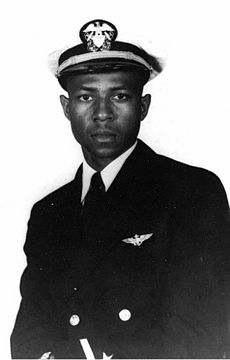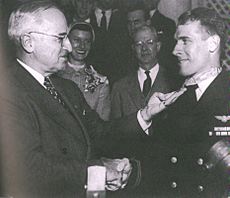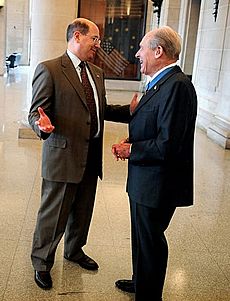Thomas J. Hudner Jr. facts for kids
Quick facts for kids
Thomas J. Hudner Jr.
|
|
|---|---|
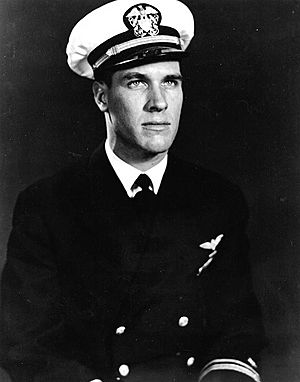
Hudner in 1950
|
|
| Nickname(s) | "Lou" |
| Born | August 31, 1924 Fall River, Massachusetts, U.S. |
| Died | November 13, 2017 (aged 93) Concord, Massachusetts, U.S. |
| Buried | |
| Allegiance | United States |
| Service/ |
United States Navy |
| Years of service | 1946–1973 |
| Rank | Captain |
| Unit |
|
| Commands held |
|
| Battles/wars | |
| Awards |
|
Thomas Jerome Hudner Jr. (born August 31, 1924 – died November 13, 2017) was a brave United States Navy officer and pilot. He became a captain. He received the Medal of Honor for trying to save his friend, Ensign Jesse L. Brown. This happened during the Battle of Chosin Reservoir in the Korean War.
Thomas Hudner was born in Fall River, Massachusetts. He went to Phillips Academy and the United States Naval Academy. At first, he wasn't interested in flying. But he later became a pilot. He joined Fighter Squadron 32. He flew the F4U Corsair plane. The Korean War began, and he was sent to Korea in October 1950. He flew missions from the aircraft carrier USS Leyte.
On December 4, 1950, Hudner and Brown were flying near the Chosin Reservoir. Brown's plane was hit by enemy fire and crashed. To save Brown from his burning plane, Hudner purposely crashed his own plane. He landed on a snowy mountain in very cold weather. Despite his efforts, Brown died from his injuries. Hudner had to leave Brown's body behind. A rescue helicopter could not fly in the dark. Hudner also got hurt when he landed his plane.
After this event, Hudner served on many U.S. Navy ships. He also worked with different aviation groups. He was even a leader on the USS Kitty Hawk during the Vietnam War. He retired from the Navy in 1973. Later, he worked for groups that help military veterans. A guided missile destroyer ship, the USS Thomas Hudner, is named after him.
Contents
Early Life and School
Thomas Hudner was born on August 31, 1924, in Fall River, Massachusetts. His father, Thomas Hudner Sr., owned a chain of grocery stores. Thomas had three younger brothers: James, Richard, and Phillip.
Hudner started at the famous Phillips Academy in Andover, Massachusetts, in 1939. His family had a long history there. His father and uncle also went to the academy. All three of his younger brothers later attended as well. While in high school, Thomas was very active. He was a team captain for the track team. He also played football and lacrosse. He was a class officer and a member of the student council.
Military Career
After the attack on Pearl Harbor, the United States joined World War II. Hudner heard a speech that inspired him to join the military. He was one of 10 students from his class to be accepted. He entered the United States Naval Academy in Annapolis, Maryland, in 1943. He graduated in 1946. By then, World War II had ended.
Hudner served as a communications officer on several ships. At first, he wasn't interested in planes. After a year on the USS Helena near Taiwan, he moved to Pearl Harbor. He worked there for another year. By 1948, Hudner became interested in flying. He applied to flight school, looking for "a new challenge." He was accepted into Naval Air Station Pensacola in Florida. He finished basic flight training there. Then he went to Naval Air Station Corpus Christi in Texas. He completed advanced training and became a naval aviator in August 1949. After a short time in Lebanon, Hudner joined VF-32. He flew the F4U Corsair from the aircraft carrier USS Leyte. He liked this plane because he found it "safe and comfortable."
The Korean War Begins
On June 25, 1950, North Korean troops invaded South Korea. The South Korean army was surprised and unprepared. The North Koreans quickly moved south. To help South Korea, the United Nations Security Council decided to send military forces. The United States and British navies sent ships. They blocked North Korea and launched planes. U.S. President Harry S. Truman also sent ground troops.
All U.S. Navy ships, including the USS Leyte, were put on alert. The ship was in the Mediterranean Sea. Hudner did not expect to go to Korea. But on August 8, the Leyte was ordered to Korea. Naval leaders felt the pilots on Leyte were well-trained. So, they were among the first sent to the war zone. The Leyte sailed across the Atlantic Ocean, through the Panama Canal, and to Japan. It arrived near Korea around October 8.
The ship joined Task Force 77 off the Korean coast. This fleet had 17 ships. Hudner flew 20 missions in Korea. He attacked enemy communication lines, troop groups, and military bases. In late November 1950, China joined the war. Hudner and his squadron were sent to the Chosin Reservoir. A fierce battle was happening there. Almost 100,000 Chinese troops surrounded 15,000 U.S. troops. Pilots from the Leyte flew many missions. They helped prevent the Chinese from taking over the area.
A Heroic Act: The Medal of Honor
On December 4, 1950, Hudner was part of a group of six planes. They were helping U.S. Marine Corps troops. These troops were surrounded by Chinese forces. At 1:38 PM, Hudner took off from the Leyte. His group included Ensign Jesse L. Brown, who was the first African American Naval Aviator. Brown was Hudner's wingman. The planes flew about 100 miles to the Chosin Reservoir. The weather was very cold and harsh. They flew for 35 to 40 minutes.
The pilots looked for targets. They flew lower, about 700 feet high. At 2:40 PM, another pilot told Brown his plane was leaking fuel. Chinese soldiers hiding in the snow had likely shot his plane. A bullet had hit a fuel line. Brown was losing control of his plane. He tried to land in a snowy clearing on a mountain. Brown crashed into a valley. It was about 15 miles behind Chinese lines. The temperature was 15 degrees Fahrenheit (-10 °C).
Brown's plane broke apart. His leg was trapped under the plane. He took off his helmet and gloves to try to get free. He waved to the other pilots flying above. Hudner and the others thought Brown had died. They immediately called for a rescue helicopter. Brown's plane was smoking, and a fire started near its fuel tanks.
Hudner tried to help Brown using the radio, but it didn't work. So, he purposely crashed his own plane nearby. He ran to Brown's side. He tried to pull him free from the wreckage. Brown's condition was getting worse. Hudner tried to put out the fire with snow. He tried to pull Brown out, but he couldn't. Brown started to lose consciousness. He was in great pain but did not complain.
A rescue helicopter arrived around 3:00 PM. Hudner and the helicopter pilot, Lieutenant Charles Ward, tried to put out the fire. They used a fire extinguisher, but it didn't work. They tried to free Brown with an axe for 45 minutes. Brown asked them to cut off his trapped leg. But he lost consciousness for the last time soon after. His last words to Hudner were, "Tell Daisy I love her." The helicopter could not fly in the dark. So, it had to leave at nightfall with Hudner. They left Brown behind. Brown likely died soon after from his injuries and the extreme cold. No Chinese forces came to the crash site. This was probably because of the many planes flying overhead.
Hudner wanted to go back to the crash site to get Brown's body. But his commanders said no. They feared an ambush by the enemy. To stop the body and plane from falling into enemy hands, the U.S. Navy bombed the site. Two days later, they used napalm. The pilots said the Lord's Prayer over the radio as they watched the flames. They saw that Brown's body looked disturbed, and his clothes were gone. But he was still stuck in the plane. Brown's body and the plane were never found. Brown was the first African American U.S. Navy officer killed in the war.
The incident on December 4 kept Hudner from flying for a month. He hurt his back when he landed. He said this injury bothered him for 6 to 8 years. He flew 27 combat missions during the war. He served until January 20, 1951. Then the Leyte went back to the Atlantic Fleet. On April 13, 1951, Hudner received the Medal of Honor from President Harry S. Truman. He also met Brown's widow, Daisy Brown. They stayed in touch for over 50 years. Hudner was the first person to receive the medal during the Korean War.
Hudner later said some people criticized his actions. About 90 people told him he acted carelessly. His commanders noted his actions might have put the helicopter pilot in danger. They also said he sacrificed an aircraft. Hudner said these criticisms did not make him regret his decision. He felt it was a quick decision in the moment. Still, commanders later ordered pilots not to crash-land in a similar way. This was to prevent more casualties. Hudner said he did not see himself as a hero for what he did.
After receiving the Medal of Honor, Hudner moved back to the United States. He worked as a flight instructor in Texas in 1952 and 1953. After that, he served as a staff officer for Carrier Division 3. This group was operating near Japan in 1953 and 1954. In 1955 and 1956, he worked in Air Development Squadron 3 in New Jersey. There, he flew new and experimental aircraft. During this time, he learned to fly jet engine-powered planes.
In October 1957, Hudner joined a program with the U.S. Air Force. He flew for two years with the 60th Fighter-Interceptor Squadron in Massachusetts. He flew the F-94 Starfire and the F-101 Voodoo. He was then promoted to commander. He worked as an aide until 1962. Then he attended the Air War College in Alabama. After graduating in July 1963, he returned to flying. He became the executive officer of Fighter Squadron 53. He flew the F-8E Crusader from the USS Ticonderoga. After this, Hudner took command of VF-53. He then became a Leadership Training Officer in California.
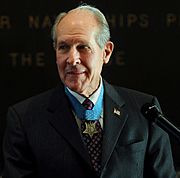
Hudner was promoted to captain in 1965. He took command of Training Squadron 24 in Texas. He led this squadron in 1965 and 1966. In 1966, he was assigned to the USS Kitty Hawk. He served as navigator, then as the ship's executive officer. The Kitty Hawk was sent near South Vietnam in 1966 and 1967. It launched missions to support the Vietnam War. Hudner served on the ship during this time. But he did not fly combat missions himself. In 1968, he became the operations officer for U.S. Navy air operations in Southeast Asia. That year, he married Georgea Smith. She was a widow with three children. They had one son together, Thomas Jerome Hudner III, born in 1971. Hudner's last Navy job was leading Aviation Technical Training in Washington, D.C. He held this job until he retired in February 1973.
On February 17, 1973, days before Hudner retired, the Navy launched a ship. It was the Knox-class frigate USS Jesse L. Brown. This was the third U.S. ship named after an African American. Daisy Brown Thorne, Jesse Brown's widow, was at the ceremony in Boston, Massachusetts. Her daughter Pamela Brown and Hudner were also there. Hudner gave a speech. The ship was later sold to Egypt.
Later Life and Passing
After retiring, Hudner first worked as a management consultant. Later, he worked with the United Service Organizations. Because he had the Medal of Honor, he often worked with veterans' groups. He was a leader in the veterans' community. Otherwise, he lived a quiet life. From 1991 to 1999, he was a Commissioner for the Massachusetts Department of Veterans' Services. He then gave the job to another Medal of Honor recipient, Thomas G. Kelley.
He received many honors later in his life. In 1989, the Air Force honored him. In 2001, Hudner gave Daisy Brown Thorne several of Jesse Brown's medals. In May 2012, the Secretary of the Navy announced a new ship. An guided missile destroyer would be named USS Thomas Hudner. The ship was named on April 1, 2017. Hudner was there for the event. It was officially put into service in Boston on December 1, 2018.
After 1991, Hudner lived in Concord, Massachusetts, with his wife, Georgea. In July 2013, he visited Pyongyang, North Korea. He tried to find Jesse Brown's remains from the crash site. North Korean officials told him to return in September. The weather would be better then.
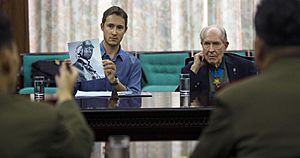
Hudner's official biography was released in October 2015. It was called Devotion: An Epic Story of Heroism, Friendship, and Sacrifice. He worked with author Adam Makos for seven years on the book.
Thomas Hudner died at his home in Concord, Massachusetts, on November 13, 2017. He was 93 years old. He was buried at Arlington National Cemetery on April 4, 2018. General Joseph Dunford attended the ceremony.
Hudner is shown in the 2022 movie Devotion. He is played by Glen Powell.
Awards and Honors
In Film and Books
- Film: Devotion (2022)
- Book: Devotion: An Epic Story of Heroism, Friendship, and Sacrifice (2015)
See Also
 In Spanish: Thomas J. Hudner, Jr. para niños
In Spanish: Thomas J. Hudner, Jr. para niños


